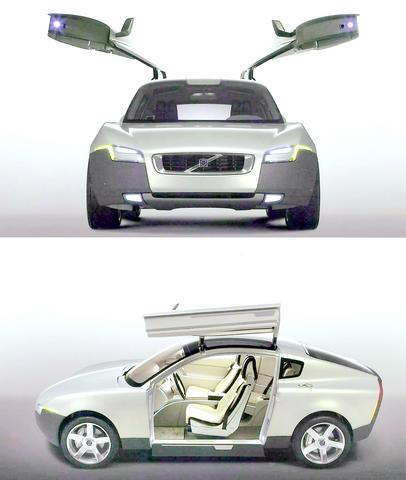Car shows, it has to be said, are for men. The talk is of torque and horsepower. The biggest names, Porsche and Ferrari, are testosterone on wheels, while the lesser ones adorn their cars with slinky women, lending these shows a retro feel that is part The Price Is Right, part Playboy Club.
So when Volvo rolled into the Geneva Motor Show this week with a car designed by women, for women, the reaction among the mostly male crowd can best be described as a collective grinding of the gears.
They gaped at the car's gull-wing doors, designed to make it easier for women to enter and exit. They clucked at the rear seats, which flip up like theater seats to store shopping bags. They lampooned a rubber bumper that swathes the car, protecting it from parking-lot dings and scratches.

PHOTO: EPA
"It's not even a theory, it's nonsense," said Michael Ganal, the head of sales and marketing for BMW.
Robert Lutz, the vice chairman of General Motors, said the whole idea was sexist.
"Most women would say: `I send my husband out to do the shopping. Let him have the car with the rubber bumpers,'" he said.
With this much vitriol, it is obvious that Volvo, the Swedish subsidiary of the Ford Motor Co, is tweaking the folkways of the industry. The question is whether Volvo's car will prove to be a gimmick or a pioneering response to the growing influence of female consumers in the auto market.
Volvo's designers concede that their car, known as the YCC, will not be built in anything close to its current form. But they said that many of its innovations are sure to turn up in other Volvo models. Given that 54 percent of its customers in the US are women, that could be shrewd marketing.
"Men and women really want the same things in cars," Camilla Palmertz, 36, the Volvo project manager, said. "But women want more. There's no car out there right now that fulfills all their criteria."
Over the last year, Volvo set loose a 120-person team to design a car that would meet what Palmertz said were the six main desires of female car buyers: ease of parking, comfortable seats, visibility, ample storage space, easy maintenance and the ability to personalize one's vehicle.
Not every member of the team was a woman, Palmertz said, but the core group of project leaders and designers was restricted to women. Aside from the go-ahead for the project, which was given by Volvo's chief executive, Hans-Olov Olsson, all major decisions were made by women.
The resulting vehicle looks nothing like the rounded minivans or hatchbacks that carmakers have historically aimed at women. With a sweeping roof and large alloy wheels, plus squat, sturdy dimensions, the YCC has a hybrid style that its designers liken to a rugged sports coupe.
"We're typical women," said Anna Rosen, who designed the exterior. "We want a mix of the best of everything."
Rosen, 28, said the car was aimed at independent women. While they could be mothers, the more likely owner is single. With computer-assisted parallel parking, the car is clearly designed for city streets.
For decades, carmakers have tried, however clumsily, to appeal to women. In the 1950s, Dodge introduced a pink car known as "La Femme," which had a compartment on the back of the seat that held cosmetics.
It was a fiasco, which Lutz said led Detroit to steer clear of cars that played to gender stereotypes.
In recent years, Ford, Nissan and Mazda have all used female designers to devise women-friendly touches for cars and vans. Even Porsche, the German sports car maker synonymous with manly motoring, sought to appeal to women with its new sport utility vehicle, the Cayenne.
But the industry has avoided labeling cars as women-friendly because it does not want to alienate half its market. For the same reason, companies try to avoid being tagged as catering to older customers.
"Volvos, because they are safe, did come to appeal to more mature drivers," said Garel Rhys, director of the automotive industry research group at Cardiff University in Wales. "I used to say laughingly that Volvo should put Braille on its steering wheel. They didn't like that image."
Like other carmakers, Volvo is predominantly male. But Sweden is an unusually egalitarian society, even by Western standards. Several executives said it was no surprise that this project happened there.
"This is not just a token gesture," said Mark Fields, the head of Ford's Premier Automotive Group, which includes Volvo, Jaguar, and Land Rover. "What we're really testing is a list of options."
Some of the car's features benefit men as much as women. A computer records the driver's body measurements so that each time he or she climbs into the car, the seat and steering wheel adjust. The gasoline tank has a roller-ball valve opening, like a race car, so one does not have to unscrew a cap.
Other devices seem more women-friendly. The seat covers can be easily removed, giving the owner the option of changing colors and patterns. The head-rests have a gap in the center to accommodate a ponytail.
The doors, which swing up and out at the touch of a button, are the car's most eye-catching detail. Volvo's designers say they would be a godsend to a woman laden with shopping bags. Other carmakers dared Volvo to try to open the doors in an average-size garage.
The wrap-around bumper drew similar catcalls. Rosen said the car could tolerate "creative driving" in parking lots and other tight spaces, without having to be returned to the shop for repairs. Lutz said this perpetuated the image that women are worse drivers than men.
Volvo's rivals do not dispute the growing influence of women. BMW estimates that in the US, 50 percent to 60 percent of the drivers of its X5 sport utility vehicle are female.
But Ganal said: "We never approach a car by asking, Is the car more used by males or females? We ask, What is the purpose of the car?"
Even Volvo's designers accepted one limitation. The Volvo emblem is its name stamped on the universal symbol of the male gender, a circle with an arrow pointing up and to the right. The designers said they toyed with the idea of changing the emblem to the universal symbol for woman.
Then, said Lena Ekelund, the project's deputy technical manager, "we decided we would just leave it alone."

CHIP RACE: Three years of overbroad export controls drove foreign competitors to pursue their own AI chips, and ‘cost US taxpayers billions of dollars,’ Nvidia said China has figured out the US strategy for allowing it to buy Nvidia Corp’s H200s and is rejecting the artificial intelligence (AI) chip in favor of domestically developed semiconductors, White House AI adviser David Sacks said, citing news reports. US President Donald Trump on Monday said that he would allow shipments of Nvidia’s H200 chips to China, part of an administration effort backed by Sacks to challenge Chinese tech champions such as Huawei Technologies Co (華為) by bringing US competition to their home market. On Friday, Sacks signaled that he was uncertain about whether that approach would work. “They’re rejecting our chips,” Sacks

Taiwan’s long-term economic competitiveness will hinge not only on national champions like Taiwan Semiconductor Manufacturing Co. (TSMC, 台積電) but also on the widespread adoption of artificial intelligence (AI) and other emerging technologies, a US-based scholar has said. At a lecture in Taipei on Tuesday, Jeffrey Ding, assistant professor of political science at the George Washington University and author of "Technology and the Rise of Great Powers," argued that historical experience shows that general-purpose technologies (GPTs) — such as electricity, computers and now AI — shape long-term economic advantages through their diffusion across the broader economy. "What really matters is not who pioneers

BUBBLE? Only a handful of companies are seeing rapid revenue growth and higher valuations, and it is not enough to call the AI trend a transformation, an analyst said Artificial intelligence (AI) is entering a more challenging phase next year as companies move beyond experimentation and begin demanding clear financial returns from a technology that has delivered big gains to only a small group of early adopters, PricewaterhouseCoopers (PwC) Taiwan said yesterday. Most organizations have been able to justify AI investments through cost recovery or modest efficiency gains, but few have achieved meaningful revenue growth or long-term competitive advantage, the consultancy said in its 2026 AI Business Predictions report. This growing performance gap is forcing executives to reconsider how AI is deployed across their organizations, it said. “Many companies

TAIWAN VALUE CHAIN: Foxtron is to fully own Luxgen following the transaction and it plans to launch a new electric model, the Foxtron Bria, in Taiwan next year Yulon Motor Co (裕隆汽車) yesterday said that its board of directors approved the disposal of its electric vehicle (EV) unit, Luxgen Motor Co (納智捷汽車), to Foxtron Vehicle Technologies Co (鴻華先進) for NT$787.6 million (US$24.98 million). Foxtron, a half-half joint venture between Yulon affiliate Hua-Chuang Automobile Information Technical Center Co (華創車電) and Hon Hai Precision Industry Co (鴻海精密), expects to wrap up the deal in the first quarter of next year. Foxtron would fully own Luxgen following the transaction, including five car distributing companies, outlets and all employees. The deal is subject to the approval of the Fair Trade Commission, Foxtron said. “Foxtron will be